Changes in Groundwater Vulnerability Due to Land Reclamation in Mining Areas: An Assessment Using the DRASTIC Method
Abstract
1. Introduction
1.1. Land Reclamation Processes
- -
- Reclamation of arid land—In the western United States, extensive reclamation efforts, led by the United States Bureau of Reclamation, focus on irrigation through the construction and maintenance of dams, canals, and pumping systems. Notable projects include over 600 dams such as the Grand Coulee Dam on the Columbia River and Hoover Dam on the Colorado River. Similar reclamation activities are also being undertaken in Israel, Egypt, Middle Eastern countries, India, Mexico, Peru, Russia, and China, with historical projects dating back to the mid-19th century in the Great Salt Lake basin and California.
- -
- Reclamation of swampy lands—In areas where the land is rendered unfit for agricultural production, even where the wet soil condition is only temporary, the water needs to be removed by various drainage systems by ditches, drains, or wells. The water removal method depends on the permeability of the soil and underlying strata and the main drainage base elevation. An example can be the Everglades of Florida, the lower Mississippi valley, or projects found in England, near Minsk, Belarus, New Zealand, Australia, and others.
- -
- Reclamation of coastal areas—Areas where offshore lands or tidal marshes are covered by shallow water. Construction of dikes parallel to the shoreline, drainage of the area between the dikes and the coastline, closing the mouth of tidal estuaries, polder constructions or ground raising is practised to obtain coal. The greatest achievements were in the Netherlands (7000 km2), England, and also in the Carolinas and Georgia in the United States. Others are known in China (over 13,500 km2), Hong Kong, Dubai, and the Gran Chaco region of Paraguay [3].
- -
- Reclamation of mine spoils—Areas where mineral deposits lie near the surface, leading to surface mining practices in regions like the United States, England, Serbia, and others, targeting deposits like phosphates, gypsum, gravel, limestone, copper, iron, coal, and more. Historically, lands were often abandoned after exploitation, with no prospects for future development. This issue was addressed in 1950 when states such as Pennsylvania, West Virginia, Ohio, and Indiana passed laws requiring the restoration of strip-mined areas. Eastern Europe saw a similar trend in surface mine reclamation in the late 20th century. The main goals of reclaiming tailing dump areas include reforestation, creating grazing lands, and developing recreational areas.
- -
- Reclamation of eroded, infertile, and “new” lands—Areas where soil erosion is severe, caused by lack of vegetation, and sediment susceptibility to erosion driven by climate factors. Such cases are known from Atri, Italy, southern Virginia, and southwestern South Dakota.
1.2. Groundwater Vulnerability in Reclamation Process
2. Methodology
2.1. Hydrogeology of the Area
2.2. DRASTIC Method
3. Results
3.1. Change in Parameter Class
3.2. DRASTIC Index
3.3. Sensitivity Analysis and DRASTIC Optimisation
4. Discussion
5. Conclusions
- Reclamation will significantly affect all the parameters of the DRASTIC method. These will primarily be the following: a decrease in the depth to the water table, a decrease in the magnitude of recharge, the formation of groundwater flow in waste rock, the formation of new soil types, a decrease in land slopes, and a decrease in the value of the hydraulic conductivity. The largest changes involved a decrease in the number of D and T parameter classes after reclamation from eight to four. The largest areas were affected by changes in the A and I parameters, which were associated with a decrease in their values by four classes.
- The extent of change in vulnerability in relation to the exploitation phase includes both a decrease and an increase in vulnerability. The decrease in vulnerability over approximately 67% of the area relates to the central part where the drainage systems are located. The adopted reclamation direction will result in a reduction in the risk of pollution seepage from the surface. For 31% of the area, there will be a reduction in the vulnerability index by at least one class, and for 6% by at least two classes.
- There will be an increase in vulnerability in approximately 33% of the area, in previously reclaimed areas, and where floodings will form as a result of rising groundwater tables. In these areas, there will be a change of at least one class.
- The optimisation procedure in the two development phases revealed different values for the effective weights obtained, indicating the need to recalculate them in each case for the subsequent variants. After the reclamation, it was found that the effective weight of the D parameter is significantly higher, while the S and T parameters remain the least changed and least significant.
- The planned reclamation requires modification of the existing groundwater-monitoring network. In the case under consideration, monitoring of the quantitative and chemical status of groundwater is particularly important in areas where flooding is possible, which may lead to increased dissolution or diffusion of chemicals from rocks and pore fluids and their further migration in the groundwater stream. A modification of the existing monitoring network is planned for this situation.
Author Contributions
Funding
Data Availability Statement
Conflicts of Interest
References
- Britannica, The Editors of Encyclopaedia. “Land Reclamation”. Encyclopedia Britannica. 10 August 2023. Available online: https://www.britannica.com/science/land-reclamation (accessed on 26 June 2024).
- Powter, C. Glossary of Reclamation and Remediation Terms Used in Alberta; Government of Alberta: Edmonton, AB, USA, 2002; ISBN 0-7785-2156-7.
- Available online: https://rics-stage21.adobecqms.net/uk/en/modus/natural-environment/land.html (accessed on 26 June 2024).
- Geological and Mining Law. Act of 9 June 2011. Journal of Laws 2011, No. 163, Item 981. Available online: https://isap.sejm.gov.pl/DetailsServlet?id=WDU20110001050 (accessed on 10 January 2025).
- Act on Protection of Agricultural and Forestry Land. Act of 3 February 1995. Journal of Laws 1995, No. 16, Item 78. Available online: https://isap.sejm.gov.pl/DetailsServlet?id=WDU19950160078 (accessed on 10 January 2025).
- Bukowski, P.; Bromek, T.; Augustyniak, I. Using the DRASTIC system to assess the vulnerability of groundwater to pollution in mined areas of the upper Silesian Coal Basin. Mine Water Environ. 2006, 25, 15–22. [Google Scholar] [CrossRef]
- Witkowski, A.; Kowalczyk, A. Assessment of vulnerability to pollution or the degree of threat to groundwater in coal mining areas in the GZW. In Selected Problems of Geological and Hydrogeological Investigations for Mining and Energy Industries; Bukowski, P., Ed.; Wydawnictwo GIG: Katowice, Poland, 2012; pp. 107–121. [Google Scholar]
- Tiwari, A.K.; Singh, P.K.; De Maio, M. Evaluation of aquifer vulnerability in a coal mining of India by using GIS-based DRASTIC model. Arab. J. Geosci. 2016, 9, 438. [Google Scholar] [CrossRef]
- Góra, S.; Szczepański, A. Feasibility of selected methods for assessing vulnerability of the ground and water environment in the north-eastern part of the Upper Silesian Coal Basin. Biul. Państwowego Inst. Geol. 2009, 436, 115–120. [Google Scholar]
- Haque, E.; Reza, S.; Ahmed, R. Assessing the vulnerability of groundwater due to open pit coal mining using DRASTIC model: A case study of Phulbari Coal Mine, Bangladesh. Geosci. J. 2018, 22, 359–371. [Google Scholar] [CrossRef]
- Haładus, A.; Bukowski, P.; Krogulec, E. Assessment of groundwater vulnerability to pollution in the GZW area. Przegląd Gor. 2013, 1, 51–56. [Google Scholar]
- Bukowski, P.; Krogulec, E.; Haładus, A. Characterisation of the main area geotypes of groundwater vulnerability assessments. Przegląd Geol. 2020, 68, 226–232. [Google Scholar] [CrossRef]
- Aller, L.; Bennett, T.; Lehr, J.H.; Petty, R.J.; Hackett, G. DRASTIC: A Standardized System for Evaluating Ground Water Pollution Potential Using Hydrogeologic Settings; EPA-600/2-87-035, EPA; US Environmental Protection Agency: Washington, DC, USA, 1987.
- Singh, V.; Karan, S.; Samadder, S.R. Landfll site selection in a mining dominated area using a fuzzy AHP and DRASTIC vulnerability based multicriteria decision analysis: A case study of Dhanbad, India. Environ. Monit. Assess 2023, 195, 1172. [Google Scholar] [CrossRef]
- Karan, S.; Samadder, S.R.; Singh, V. Groundwater vulnerability assessment in degraded coal mining areas using the AHP–Modified DRASTIC model. Land Degrad. Dev. 2018, 29, 2351–2365. [Google Scholar] [CrossRef]
- Krogulec, E.; Bukowski, P.; Niedbalska, K.; Trzeciak, J.; Zabłocki, S. Groundwater vulnerability to pollution in degraded coal mining areas: Modifying the DRASTIC method using the factor of exploitation impact on land surface. Geol. Geophisics Environ. 2023, 49, 313–334. [Google Scholar] [CrossRef]
- Bromek, T.; Bukowski, P. Assessing the permeability of backfill materials used for mine shaft decommissioning. Przegląd Gor. 2002, 11, 18–23. [Google Scholar]
- David, K.; Timms, W.; Mitra, R. Groundwater Vulnerability and Pollution Risk Assessment; Imprint CRC Press: Leiden, The Netherlands, 2020; ISBN 9780367822927. [Google Scholar]
- Li, K.; Gu, Y.; Li, M.; Zhao, L.; Ding, J.; Lun, Z. Spatial analysis, source identification and risk assessment of heavy metals in a coal mining area in Henan, Central China. Int. Biodeterior. Biodegrad. 2018, 128, 148–154. [Google Scholar] [CrossRef]
- Fungaro, D.A.; Izidoro, J.C. Remediação da drenagem ácida de mina usando zeólitas sintetizadas a partir de cinzas leves de carvão. Quim Nov. 2006, 29, 735–740. [Google Scholar] [CrossRef]
- Civita, M. Le carte della vulnerabilità degli acquiferi all’inquinamento: Teoria e pratica. Quad. Tec. Prot. Ambient. Sez. “Prot. Acque Sotter. 1994, 31, 633–643. [Google Scholar]
- Wenyong, W.; Shiyang, Y.; Honglu, L. Groundwater Vulnerability Assessment and Feasibility Mapping Under Reclaimed Water Irrigation by a Modified DRASTIC Model. Water Resour. Manag. 2014, 28, 1219–1234. [Google Scholar] [CrossRef]
- Ghosh, A.; Tiwari, A.K.; Das, S. A GIS based DRASTIC model for assessing groundwater vulnerability of Katri Watershed, Dhanbad, India. Model. Earth Syst. Environ. 2015, 1, 11. [Google Scholar] [CrossRef]
- Kropka, J.; Witkowski, A.; Waligóra, J.; Rubin, H.; Kaźmierczak, J. Hydrogeological Documentation Defining Hydrogeological Conditions in Connection with the Alteration of the Dewatering for the Extraction of Sand in an Open Pit CTL Maczki-Bór S.A.; Unpublished Work; University of Silesia: Sosnowiec, Poland, 2013. [Google Scholar]
- Stupnicka, E. Regional Geology of Poland; Wydawnictwa Uniwersytetu Warszawskiego: Warszawa, Poland, 1997. [Google Scholar]
- Rubin, K.; Rubin, H.; Cabała, J. Expert Assessment of the Impact of Waste Used for Land Reclamation of the “Bór Wschód” Field on Groundwater Reservoirs, in Particular on the Chrzanów Reservoir (GZWP Chrzanów) at the Stage of Filling the Pit with Prognosis of Impact After Filling; University of Silesia, Faculty of Earth Sciences: Sosnowiec, Poland, 2006. [Google Scholar]
- Cudak, J.; Razowska-Jaworek, L.; Brodziński, I. GIS Database Hydrogeological Map of Poland in the Scale 1:50 000, Occurrence and Hydrodynamics, Sheet Jaworzno (944); Państwowy instytut Geologiczny—Państwowy Instytut Badawczy: Warszawa, Poland, 2005. [Google Scholar]
- Górnik, M. GIS Database Hydrogeological Map of Poland in the Scale 1:50 000, Occurrence and Hydrodynamics, Sheet Katowice (943); Państwowy instytut Geologiczny—Państwowy Instytut Badawczy: Warszawa, Poland, 2006. [Google Scholar]
- Gajowiec, B.; Siemiński, A. Hydrogeological Map of Poland on a Scale of 1:50 000; Sheet Jaworzno (944; incl. explanatory notes); Państwowy Instytut Geologiczny: Warszawa, Poland, 1997. [Google Scholar]
- Wagner, J.; Chmura, A. Hydrogeological Map of Poland in the Scale 1:50 000; Katowice Sheet (943; incl. explanatory notes); Państwowy Instytut Geologiczny: Warszawa, Poland, 1997. [Google Scholar]
- Niedbalska, K.; Haładus, A.; Bukowski, P.; Augustyniak, I.; Kubica, J. Modelling of changes of hydrodynamic conditions in the aqutic environment of the Maczki-Bór sand pit due to the fact of planned closure of mining operations (NE part of Upper Silesian Coal Basin—Poland). In Proceedings of the 11th International Mine Water Association Congress: Mine Water-Managing the Challenges, Aachen, Germany, 4–11 September 2011. [Google Scholar]
- Niedbalska, K. Forecasting the Hydrodynamic Effects of Open Pit Decommissioning by Example CTL Maczki-Bór. Doctoral Thesis, Główny Instytut Górnictwa, Katowice, Poland, 2022. [Google Scholar]
- Niedbalska, K.; Bukowski, P.; Haładus, A. Modelling of Changes in Groundwater Flow Conditions in the Vicinity of a Sublevel Tailings Storage Facility as a Tool for Verifying the Concept of Its Decommissioning and Protection of Waters Against Pollution; Krawiec, A., Jamorska, I., Eds.; Modele Matematyczne w Hydrogeologii: Toruń, Poland, 2014. [Google Scholar]
- Wilanowski, S. Detailed Geological Map of Poland in the Scale 1:50,000, Sheet 943—Katowice; Polish Geological Institute—National Research Institute (PGI-PIB): Warsaw, Poland, 2016. Available online: https://www.pgi.gov.pl/wydawnictwa-geologiczne-pig-pib/atlasy-i-mapy/434-szczega-mapa-geologiczna-polski-w-skali-150-000 (accessed on 11 January 2025).
- Kurek, S.; Paszkowski, M.; Preidl, M. Detailed Geological Map of Poland in the Scale 1:50,000, Sheet 944—Jaworzno; Polish Geological Institute—National Research Institute (PGI-PIB): Warsaw, Poland, 1991. Available online: https://www.pgi.gov.pl/wydawnictwa-geologiczne-pig-pib/atlasy-i-mapy/434-szczega-mapa-geologiczna-polski-w-skali-150-000 (accessed on 11 January 2025).
- IUNG. 2023. Available online: www.iung.pl (accessed on 11 January 2024).
- Available online: http://mapy.geoportal.gov.pl (accessed on 25 January 2024).
- GUGIK. 2023. Available online: www.gugik.gov.pl (accessed on 11 January 2024).
- Babiker, I.S.; Mohammed, M.A.A.; Hiyama, T.; Kato, K. A GIS—Based DRASTIC model for assessing aquifer vulnerability in Kakamigahara Heights. Gifu Prefecture central Japan. Sci. Total Environ. 2005, 345, 127–140. [Google Scholar] [CrossRef]
- Bauerek, A.; Bebek, M.; Frączek, R.; Paw, K.; Kasperkiewicz, W. Variability in chemical composition of acidic surface runoff water from an active mining waste heap representing sediments. Przegląd Geol. 2017, 65, 450–458. [Google Scholar]
- Wang, X.; Gao, Y.; Jiang, X.; Zhang, Q.; Liu, W. Analysis on the Characteristics of Water Pollution Caused by Underground Mining and Research Progress of Treatment Technology. Adv. Civ. Eng. 2021, 2021, 9984147. [Google Scholar] [CrossRef]
- Adamovic, D.; Ishiyama, D.; Kawaraya, H.; Ogawa, Y.; Stevanovic, Z. Geochemical characteristics and groundwater pollution in mining areas. Groundw. Sustain. Dev. 2022, 16, 100719. [Google Scholar] [CrossRef]
- Sarga-Gaczyńska, M. Dynamics of Pollutant Load Generation at Mining Waste Sites and Its Impact on the Aquatic Environment. Doctoral Dissertation, AGH, Kraków, Poland, 2007; p. 157. Available online: https://winntbg.bg.agh.edu.pl/rozprawy/9935/full9935.pdf (accessed on 11 January 2025).
- Nordstrom, D.K. Baseline and premining geochemical characterization of mined sites. Appl. Geochem. 2015, 57, 17–34. [Google Scholar] [CrossRef]
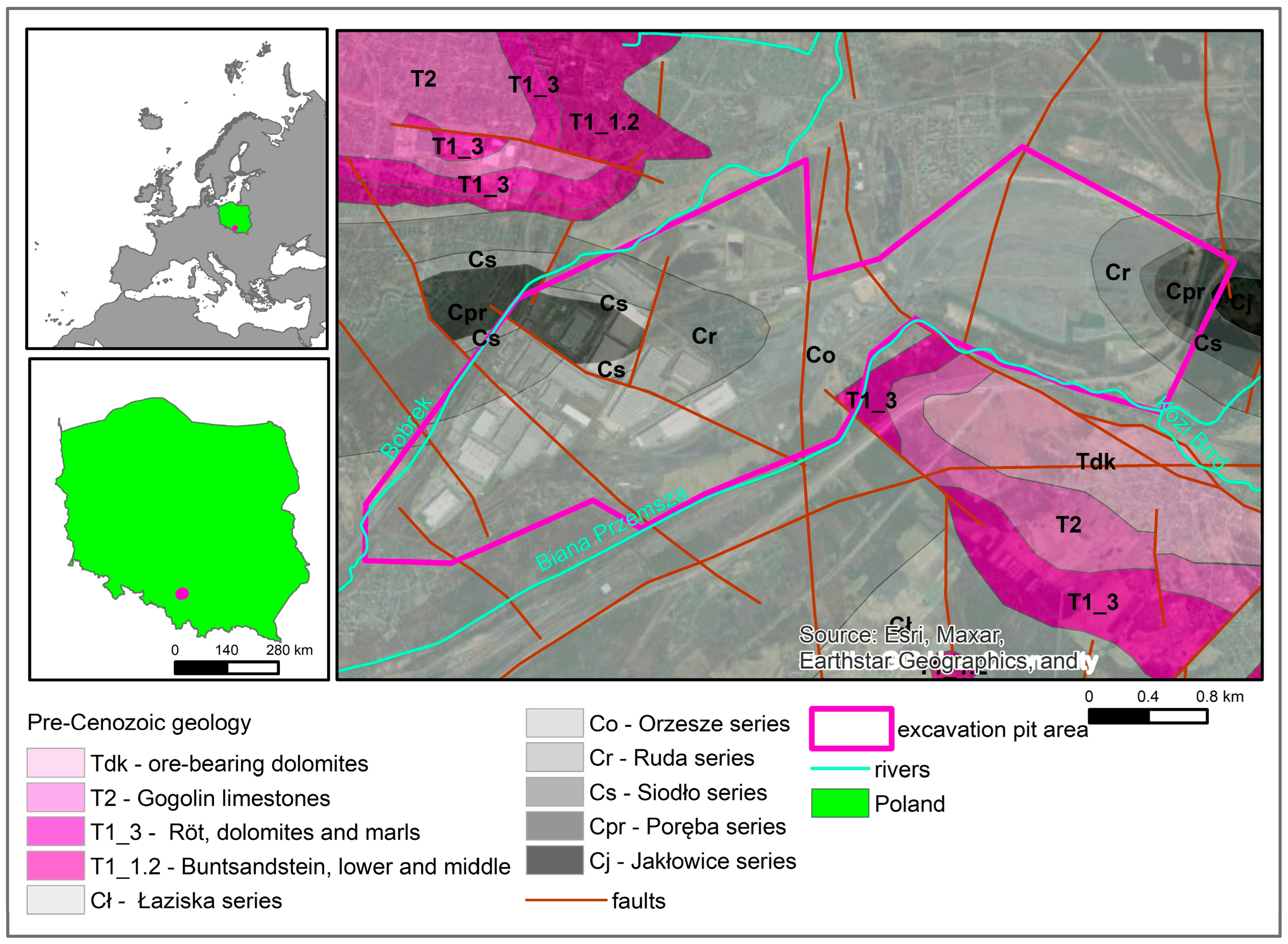


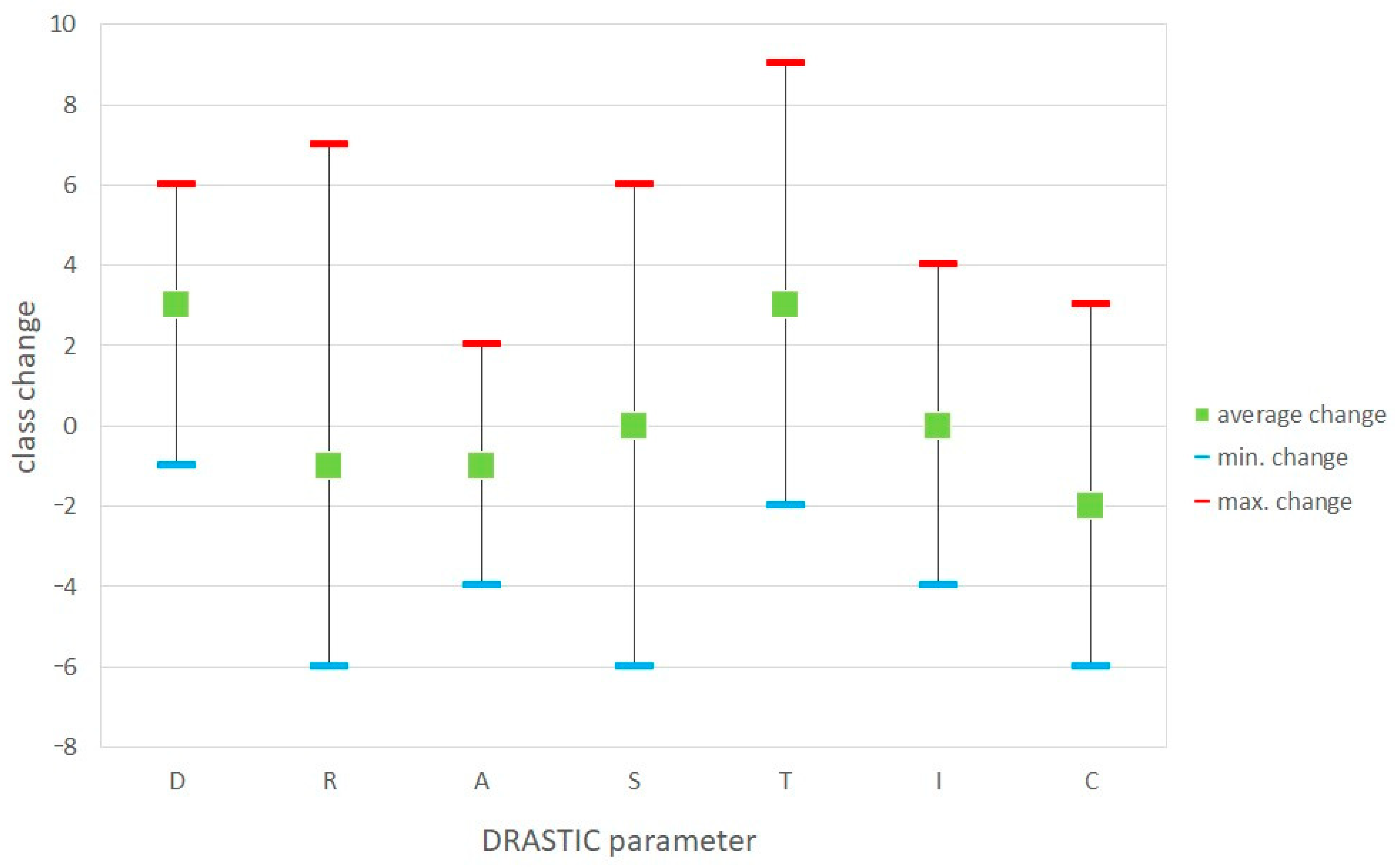
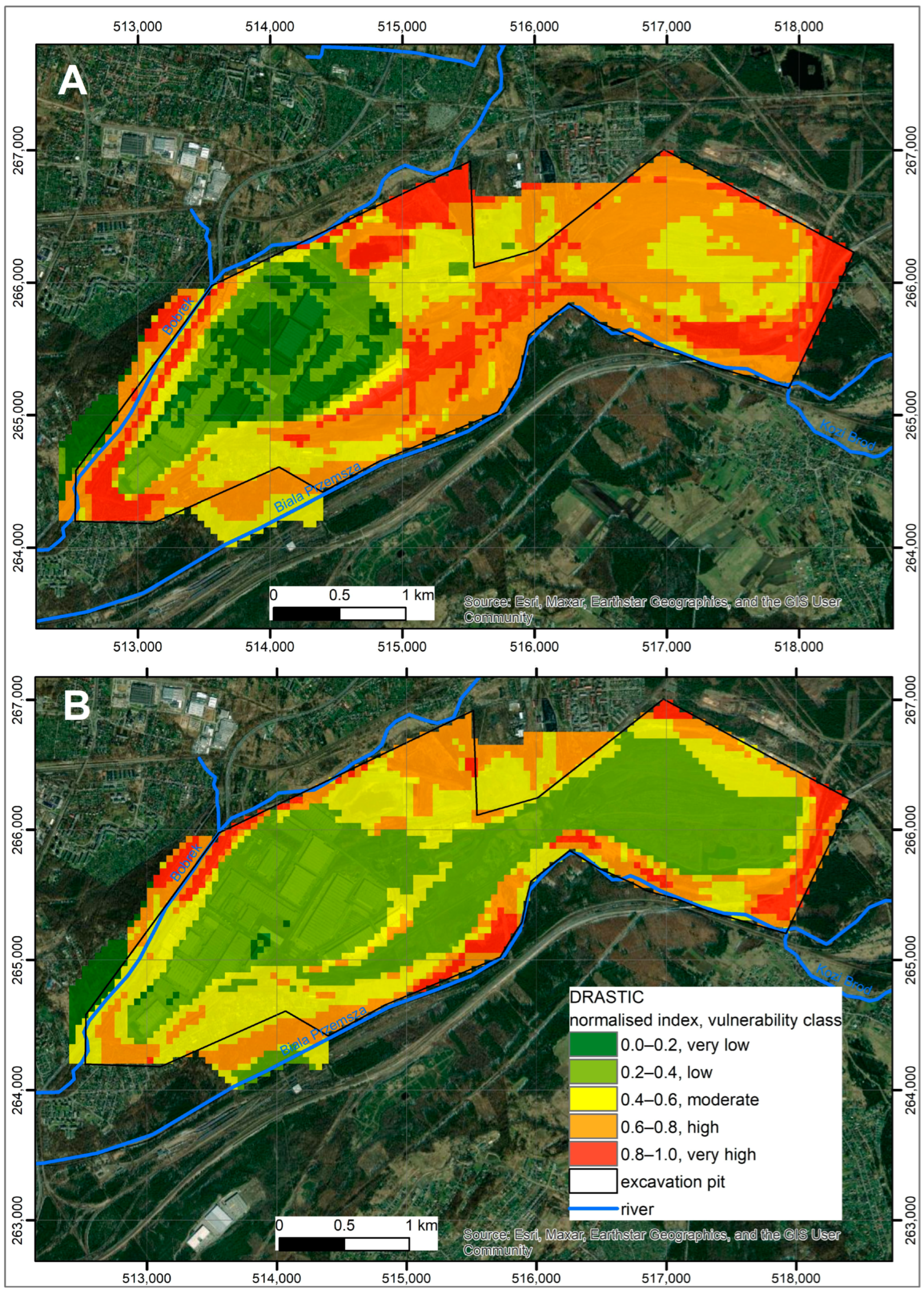

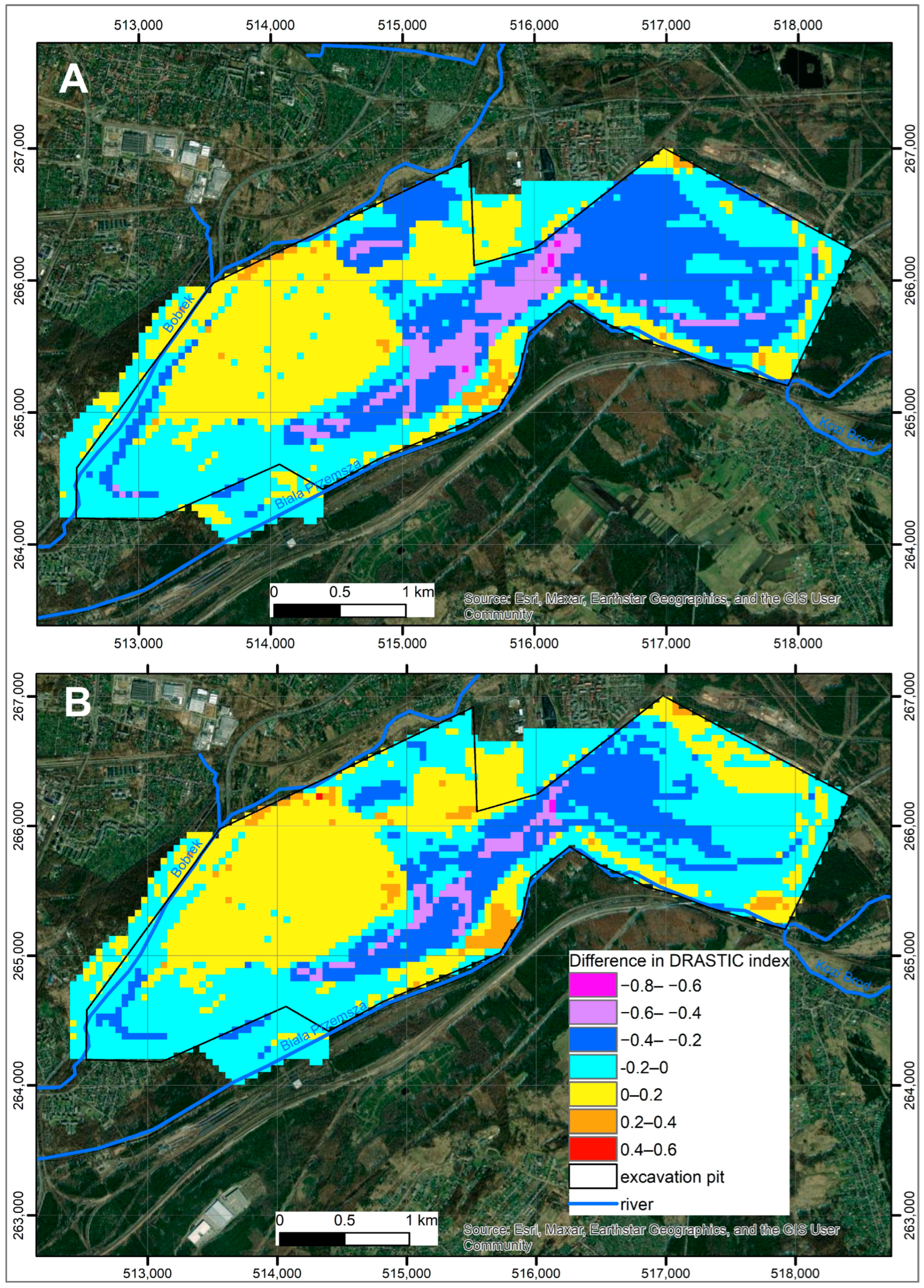
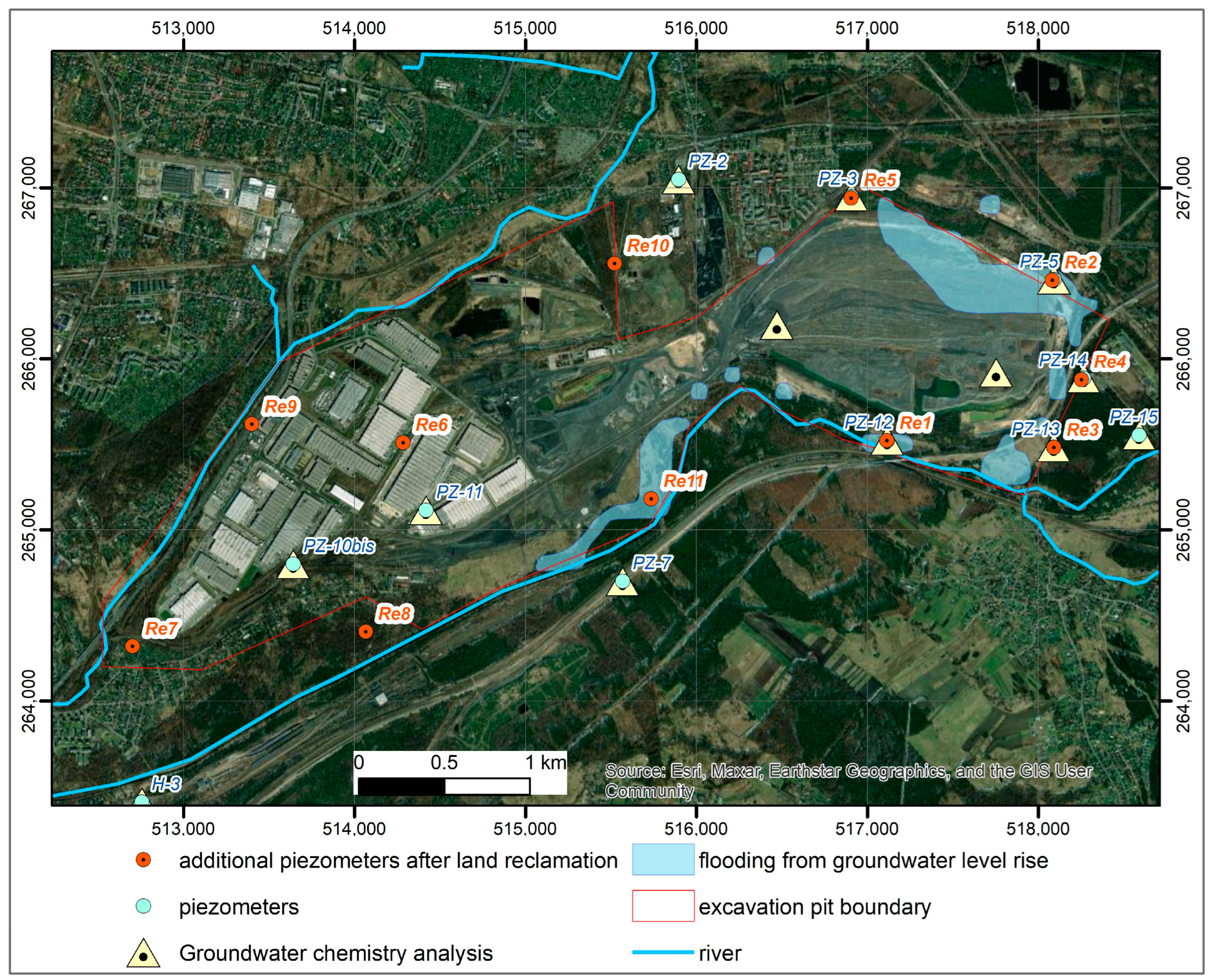
| During Mining Stage | After Land Reclamation | |
|---|---|---|
| D—Depth to groundwater | Groundwater flow scenario modelling studies developed by Niedbalska et al. [31,33] and Niedbalska [32] | Groundwater flow scenario modelling studies developed by Niedbalska et al. [31,33] and Niedbalska [32] |
| R—Recharge | Groundwater flow scenario modelling studies developed by Niedbalska et al. [31,33] and Niedbalska [32] | Groundwater flow scenario modelling studies developed by Niedbalska et al. [31,33] and Niedbalska [32] |
| A—Aquifer media | Geological descriptions of lithological units from the detailed geological map of Poland [34,35] and cross-sections [24]. | Reclamation project [24] |
| S—Soil | Map of soil genetic types at the scale of 1:500,000 [36], the detailed geological map of Poland at the scale of 1:50,000 [34,35] and analysis of a high-resolution orthophotomap [37] | After the technical land reclamation phase, the assumption was made that the landfill would be built by initial soils, and the rest of the area could slightly be changed based on reclamation projects [24] and future land use changes |
| T—Topography | Digital Elevation Model—DEM raster (Head Office of Geodesy and Cartography [38]) | Digital Elevation Model—DEM raster (Head Office of Geodesy and Cartography [38]) supplemented by projected DEM based on reclamation project [24] |
| I—Impact of vadose zone | The detailed geological map of Poland at the scale of 1:50,000 [34,35], profiles of piezometers from the observation network in the excavation pit, and hydrogeological cross-sections [24] | Reclamation project [24] |
| C—Conductivity | Groundwater flow scenario modelling studies developed by Niedbalska et al. [31,33] and Niedbalska [32] | Groundwater flow scenario modelling studies developed by Niedbalska et al. [31,33] and Niedbalska [32] |
| Parameter | Class Range Before Reclamation | Class Range After Reclamation | Class Difference Value After Reclamation | Area [ha] | Area [%] |
|---|---|---|---|---|---|
| D | 3–10 | 7–10 | −1 | 0.75 | 0.08 |
| 0 | 24.25 | 2.75 | |||
| 1 | 104.5 | 11.84 | |||
| 2 | 205 | 23.22 | |||
| 3 | 230.75 | 26.14 | |||
| 4 | 215.5 | 24.41 | |||
| 5 | 69 | 7.82 | |||
| 6 | 33 | 3.74 | |||
| R | 2–10 | 3–10 | −6 | 82.25 | 9.32 |
| −5 | 34.75 | 3.94 | |||
| −4 | 29.5 | 3.34 | |||
| −3 | 153.25 | 17.36 | |||
| −2 | 3.75 | 0.42 | |||
| −1 | 226.75 | 25.69 | |||
| 0 | 108.5 | 12.29 | |||
| 1 | 222 | 25.15 | |||
| 2 | 9 | 1.02 | |||
| 3 | 8.25 | 0.93 | |||
| 4 | 0.25 | 0.03 | |||
| 5 | 2.25 | 0.25 | |||
| 7 | 2.25 | 0.25 | |||
| A | 2–10 | 2–10 | −4 | 125.75 | 14.25 |
| −2 | 120.5 | 13.65 | |||
| 0 | 629.25 | 71.28 | |||
| 2 | 7.25 | 0.82 | |||
| S | 3–10 | 3–10 | −6 | 3.75 | 0.43 |
| −5 | 12 | 1.36 | |||
| −4 | 3.5 | 0.40 | |||
| −3 | 16.5 | 1.88 | |||
| −2 | 174.25 | 19.81 | |||
| −1 | 21.5 | 2.44 | |||
| 0 | 512.5 | 58.26 | |||
| 1 | 68.5 | 7.79 | |||
| 2 | 8.75 | 0.99 | |||
| 3 | 22.75 | 2.59 | |||
| 4 | 3.75 | 0.43 | |||
| 5 | 15 | 1.71 | |||
| 6 | 17 | 1.93 | |||
| T | 1–10 | 7–10 | −2 | 2.25 | 0.25 |
| −1 | 35.5 | 4.02 | |||
| 0 | 225.75 | 25.57 | |||
| 1 | 156 | 17.67 | |||
| 2 | 105 | 11.89 | |||
| 3 | 59.25 | 6.71 | |||
| 4 | 52.5 | 5.95 | |||
| 5 | 45.25 | 5.13 | |||
| 6 | 35.25 | 3.99 | |||
| 7 | 38.25 | 4.33 | |||
| 8 | 42 | 4.76 | |||
| 9 | 85.75 | 9.71 | |||
| I | 2–10 | 2–10 | −4 | 98.5 | 11.16 |
| −3 | 13.25 | 1.50 | |||
| −2 | 0.25 | 0.03 | |||
| −1 | 0.25 | 0.03 | |||
| 0 | 710.25 | 80.46 | |||
| 1 | 18.75 | 2.12 | |||
| 2 | 24.5 | 2.78 | |||
| 3 | 0.25 | 0.03 | |||
| 4 | 16.75 | 1.90 | |||
| C | 2–7 | 1–7 | −6 | 4.5 | 0.51 |
| −5 | 22.75 | 2.57 | |||
| −4 | 106.25 | 12.03 | |||
| −3 | 172 | 19.47 | |||
| −2 | 334.75 | 37.89 | |||
| −1 | 25.25 | 2.86 | |||
| 0 | 152.75 | 17.29 | |||
| 1 | 41.5 | 4.70 | |||
| 2 | 23.25 | 2.63 | |||
| 3 | 0.5 | 0.06 |
| Normalised Index, Vulnerability Class | Class Area for DRASTIC Before Reclamation [%] | Class Area for DRASTIC After Reclamation [%] | Change of Class Area |
|---|---|---|---|
| 0.0–0.2, very low | 10.9 | 2.35 | −8.55 |
| 0.2–0.4, low | 11.1 | 44.54 | 33.44 |
| 0.4–0.6, moderate | 22.5 | 27.42 | 4.92 |
| 0.6–0.8, high | 38.6 | 20.01 | −18.59 |
| 0.8–1.0, very high | 16.9 | 5.69 | −11.21 |
| Parameter | Theoretical Weight | Effective Weight Before Land Reclamation | Effective Weight After Land Reclamation | |||
|---|---|---|---|---|---|---|
| [-] | [%] | [-] | [%] | [-] | [%] | |
| D | 5 | 21.74 | 4.50 | 19.58 | 6.87 | 28.85 |
| R | 4 | 17.39 | 3.64 | 15.81 | 2.85 | 11.96 |
| A | 3 | 13.04 | 3.98 | 17.30 | 3.50 | 14.72 |
| S | 2 | 8.70 | 2.11 | 9.19 | 2.01 | 8.45 |
| T | 1 | 4.35 | 1.11 | 4.82 | 1.44 | 6.05 |
| I | 5 | 21.74 | 5.82 | 25.31 | 5.51 | 23.15 |
| C | 3 | 13.04 | 1.84 | 7.99 | 0.82 | 3.46 |
| Normalised Index, Vulnerability Class | Class Area for Optimised DRASTIC Before Reclamation [%] | Class Area for Optimised DRASTIC After Reclamation [%] | Change of Class Area |
|---|---|---|---|
| 0.0–0.2, very low | 2.4 | 1.98 | −0.42 |
| 0.2–0.4, low | 19.1 | 18.73 | −0.37 |
| 0.4–0.6, moderate | 17.8 | 43.21 | 25.41 |
| 0.6–0.8, high | 41.7 | 28.49 | −13.21 |
| 0.8–1.0, very high | 19.0 | 7.58 | −11.42 |
Disclaimer/Publisher’s Note: The statements, opinions and data contained in all publications are solely those of the individual author(s) and contributor(s) and not of MDPI and/or the editor(s). MDPI and/or the editor(s) disclaim responsibility for any injury to people or property resulting from any ideas, methods, instructions or products referred to in the content. |
© 2025 by the authors. Licensee MDPI, Basel, Switzerland. This article is an open access article distributed under the terms and conditions of the Creative Commons Attribution (CC BY) license (https://creativecommons.org/licenses/by/4.0/).
Share and Cite
Krogulec, E.; Bukowski, P.; Niedbalska, K.; Sawicka, K.; Trzeciak, J.; Zabłocki, S. Changes in Groundwater Vulnerability Due to Land Reclamation in Mining Areas: An Assessment Using the DRASTIC Method. Water 2025, 17, 702. https://doi.org/10.3390/w17050702
Krogulec E, Bukowski P, Niedbalska K, Sawicka K, Trzeciak J, Zabłocki S. Changes in Groundwater Vulnerability Due to Land Reclamation in Mining Areas: An Assessment Using the DRASTIC Method. Water. 2025; 17(5):702. https://doi.org/10.3390/w17050702
Chicago/Turabian StyleKrogulec, Ewa, Przemysław Bukowski, Katarzyna Niedbalska, Katarzyna Sawicka, Joanna Trzeciak, and Sebastian Zabłocki. 2025. "Changes in Groundwater Vulnerability Due to Land Reclamation in Mining Areas: An Assessment Using the DRASTIC Method" Water 17, no. 5: 702. https://doi.org/10.3390/w17050702
APA StyleKrogulec, E., Bukowski, P., Niedbalska, K., Sawicka, K., Trzeciak, J., & Zabłocki, S. (2025). Changes in Groundwater Vulnerability Due to Land Reclamation in Mining Areas: An Assessment Using the DRASTIC Method. Water, 17(5), 702. https://doi.org/10.3390/w17050702






